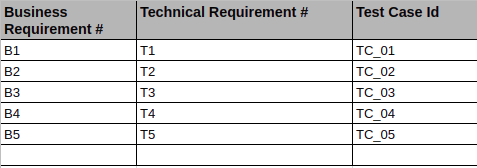Process To Create Requirements Traceability Matrix
Posted By : Neha Dahiya | 29-Mar-2018
Traceability Matrix(TM)?
Traceability Matrix is a document that is used to track the requirements of the project are met or not. It co-relates the baseline of any two documents that are in many to many
Requirement Traceability Matrix(RTM)?
All the requirements proposed by the client, software team including their traceability is captured in a single document called RTM, so that conclusion can be delivered at the right time of the life cycle.
RTM can also be defined as the document that is used to map and trace the client's requirement along with the test cases. Most important use of RTM is to check that the complete set of test cases are covered so that during the Testing no functionality is missed.
Requirement Traceability Matrix – Parameters include
- Requirement ID
- Module
- Module
- Control
- Control Type
- Functionality
- Allowed Limit, Character Type, Mandatory, Default
- Validations/Validation Message
- Additional Information
- Test cases
The Format of RTM:

How to create Requirement Traceability Matrix
Based on BRD(Business Requirement Document) and TRD(Technical Requirement Document), understand the concept of RTM.
Start writing test cases following the above concept. Look at the following table for BRD(Business Requirement Document).

Below is the format for TRD(Technical Requirement Document):

Sometimes Technical Requirement Document can also be termed as Function Requirement Document(FRD) but creation process of RTM will remain same always.
Now let’s look at the Requirement Traceability Document (RTM)

Requirements Traceability Matrix is basically the combination of Business Requirements, Technical Requirements, and Test cases. Let's have look at the advantages of RTM.
Advantages of RTM
- Traces 100% coverage of Tests
- Highlights any type of requirement say Technical or business requirement
- It covers the overall status of execution and defects
- Analyse and estimates the work of the testing team with respect to the test cases.
Thanks!
Cookies are important to the proper functioning of a site. To improve your experience, we use cookies to remember log-in details and provide secure log-in, collect statistics to optimize site functionality, and deliver content tailored to your interests. Click Agree and Proceed to accept cookies and go directly to the site or click on View Cookie Settings to see detailed descriptions of the types of cookies and choose whether to accept certain cookies while on the site.











About Author
Neha Dahiya
Neha is a bright QA Engineer with skills in manual testing . Apart from finding bugs in application, she loves sketching and painting.